Sure, it's easy to share movies from your digital camcorder or smartphone with Roxio Creator® 2012, but what about those piles of home movies and old TV shows you have stashed away on tapes? It's time to preserve your precious home recordings and transfer them to digital video.
With Roxio Creator 2012 and the Roxio Video Capture USB device, you can burn them to DVD, convert them for playback on your portable player or streaming to your TV, even upload them to YouTube™, Facebook® and more. You can also edit your recordings, add titles and transitions, and create projects combining analog footage with that from digital camcorders.
Using Roxio Creator and the capture device, you can capture and convert almost any analog video. The video capture hardware is a small USB stick with connections for both composite and S-video sources. Simply plug in the USB stick, open Roxio Creator, and you're ready to start transferring your video.
You can convert more than just tapes. Here are some common analog video sources you can capture:
- VHS tapes from your VCR
- Analog camcorder output (VHS, S-VHS, 8mm or Hi-8)
- The composite or S-video output from your TV (when viewing live standard-definition channels)
Roxio Creator and the USB capture device are also perfect for recording shows from standard-definition DVRs that don't have PC transfer capabilities. Otherwise your shows are trapped forever in the DVR. Just connect the output of the DVR to the USB capture device. (If you have a networked TiVo, see our tutorial on converting TiVo shows with Roxio Creator.)
Here's how to get started:
Step 1: Capture Video to Your PC
After you've plugged in the USB device, connect your source to the USB stick using a composite or S-video cable. Now open Roxio Creator 2012 and click on the Video-Movies tab. To transfer tapes to DVD, choose either "Plug & Burn," or "Capture Video." Plug & Burn is for when you want to go directly from tape to DVD as quickly as possible, without editing the video or saving it to your hard disk. It only takes a little longer than playing back your video to complete the burn, and is the fastest way to transfer a large number of tapes.
If you want to do more with your recordings, such as edit them, upload them to YouTube, or convert them for playback on your iPhone®, iPad® or Android™ device, it's best to use the Capture Video option, which saves your recordings to hard disk for subsequent use in all types of projects, including burning DVDs.
To use Plug & Burn, insert a blank DVD, choose a menu style and title if desired, a quality level (1 hour of high-quality video will fit on a single-layer DVD, 2 hours on a dual-layer disc), and start capturing direct to DVD. You can capture multiple pieces of video, up to the capacity of the disc. Finally, click "Finish" to complete the burn. That's all there is to it!
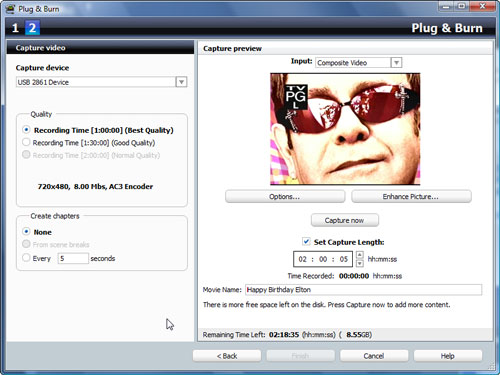
Transferring a video to DVD with Plug & Burn. (Click to enlarge.)
If you want to capture video to your hard disk for further editing or conversion, you can choose either MPEG-2 (for DVD transfer) or other digital formats, such as MP4 or AVI. It takes longer to transfer a tape to DVD with Capture Video, since capturing and burning are separate processes, but if you have the hard disk space, and think you might want to do more with your video than just burn a DVD, the extra time is worth it.
Choosing "Capture Video" from the Video-Movies tab brings up the Media Import window, as shown below. The first task is to select your video capture device from the drop-down menu. (If your PC has a built-in webcam, that will usually be the first device in the list.)
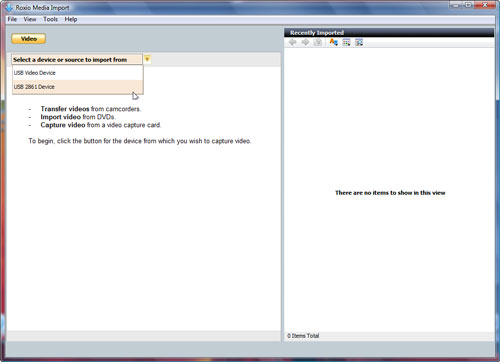
Selecting your video capture device. (Click to enlarge.)
After you select your USB stick, you'll see a preview window of the video currently being played on your source (VCR, camcorder, TV or DVR). If you don't see a picture, be sure the correct input is chosen in the menu (either Composite or S-video). Next, choose a video format for your recording (such as DV, DVD HQ, DVD SP, DVD LP or VCD). If you want to edit your video in VideoWave or CineMagic, choose DV. If you only want to burn DVDs, we recommend recording in DVD HQ format for top quality if you have the disk space (Media Import will tell you how much space you have available). Otherwise you can choose one of the more-compressed (lesser-quality) DVD options, such as DVD SP and LP. You can fit about 1 hour of HQ, 1.5 hours of SP, or 2 hours of LP video on a single-layer DVD. Dual-layer discs hold twice as much.
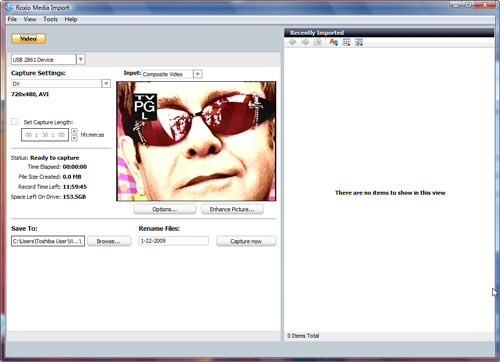
Setting up your recording. (Click to enlarge.)
Other options to choose include a capture length (so you can record unattended), a title for the recording, and video enhancements like contrast and brightness. Now click the Capture button to start recording. You'll see the progress of the recording in the Status area. When it's done, the finished video will be saved to your Videos folder (or whatever destination folder you selected), and will show up in the thumbnail list at right. Keep recording videos in this manner until you have all the material you need for your project.
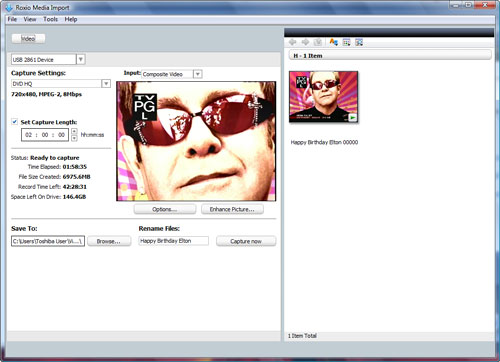
The finished recording in the movie list. (Click to enlarge.)
Step 2: Burn the Recording to DVD
Now that you've digitized all your videos, it's time to burn them to DVD. Go back to the Video-Movies tab, and choose "Create DVDs." This will start the MyDVD application, which is a full-featured DVD authoring package.
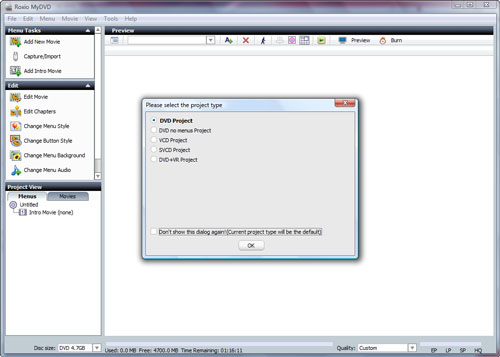
Starting up MyDVD and selecting a project type. (Click to enlarge.)
MyDVD will first ask you to select a project type, such as a standard DVD with menus, or a DVD without menus that starts playing automatically when you insert it in your player. Next, add your recordings to your project by clicking the Add Movie button and selecting them from the browser. Add as many movies as you need for your project. They will appear in a list at lower left.
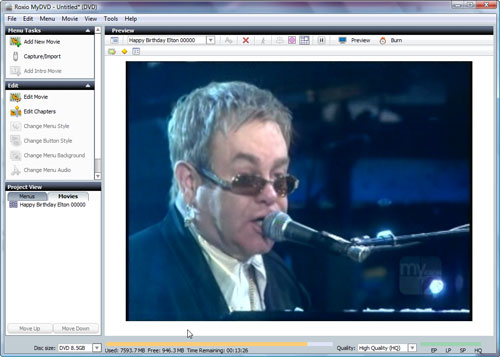
Adding the recorded movie to the DVD project. (Click to enlarge.)
If desired, you can now customize your DVD with menu styles, titles, backgrounds and chapter markers. See our MyDVD tutorial for more on what you can do with MyDVD. Once you've gotten the DVD the way you want it, press the Burn button at top right.
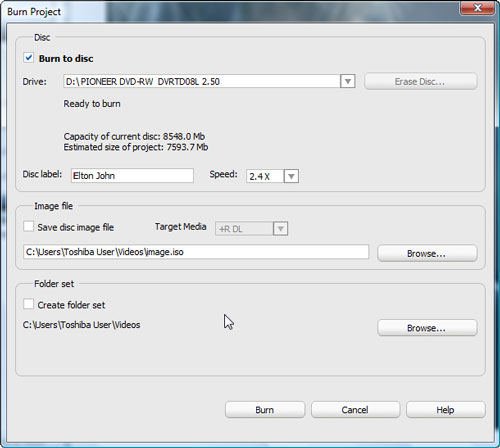
Burning the DVD.
In the Burn dialog box, you can choose your recording speed if desired, and enter a label for the disc. You can also save to an Image File on your hard disk, which is useful if you may want to burn additional copies of the disc later, or prefer play it back from your hard disk or media server.
Step 3: Do More with Your Recordings
Capturing video and burning your tapes to DVD only scratches the surface of what you can do with your digitized video. Once you've captured videos to your hard disk, you can also do things like:
- Trim and cut out unwanted portions from your recordings.
- Add titles, transition, soundtracks and more in VideoWave, the full-featured video editing program included with Roxio Creator 2012.
- Convert them for viewing on your iPhone, iPad, Android device, PSP®, or other portable player
- Post them to YouTube or Facebook
- Share them online on your own secure Web page with Roxio PhotoShow®.
Finally, Roxio Creator 2012 also includes disc label creation software, as well as the popular LP & Tape Assistant program for digitizing analog audio. Once you've converted all your old analog video and audio to digital, you'll never go back!